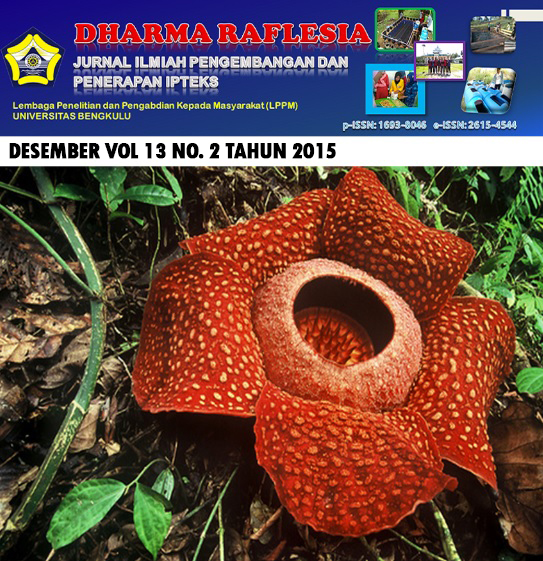Main Article Content
Abstract
PPM IbW activity program is done to transfer technology to enhance the knowledge and
skills of the society in increased production, increased value added and diversified products of sugar palm processing into a market-oriented product with stable development and small industries with sugar palm based in Lebong Regency. The general objective of this activity is to improve the knowledge and skills of palm sugar farmers in terms of increased production, increased value added and diversified products of sugar palm processing into a market-oriented product so as to increase farmers' income. IbW implementation method is a method of PALS (participatory action learning system) which is based on 3 (three) phases of activity, namely (1) the stage of awareness, (2) the stage of participating / scaffolding, and (3) the stage of institutionalization. The results of this activity in the first year are: 1) Availability of seedlings palm plants, 2) Establishment of joint venture group, 3) improvement of knowledge of craftsmen about industry integration of refined palm sugar from upstream to downstream, 4) improvement of understanding of refined palm sugar craftsmen about health production and hygiene products so as to increase the added value and income, 5) the availability of refined palm sugar maker tools, 6) improvement of the skills of the sugar producers in making refined palm sugar, 7) the availability of machines for packaging, 8) improvement of the knowledge and skills of craftsmen in designing the package, 9 ) Improvement of knowledge and skills in analyzing the results of operations and arranging financial reports, 10) productive economic empowerment for refined sugar palm craftswomen through the creation of market-oriented food products by using palm sugar as a substitute for sugar cane, 11) The formation of product marketing via the internet blogspot. While the activities carried out in the second year are: 1) Technical Assistance of palm seedlings planting, 2) Advanced assistance in palm sugar making, 3) The supply of palm sugar and coffee mixing machine, 4) Training of palm coffee making, 5) Training of Designing package and brand of palm coffee, 6) The assistance in handling business license,
7) Market/Consumer research (organoleptic test), 8) Training and scaffolding of Feasibility
Analysis palm coffee business, 9) Products promotion through seminars, exhibitions and competitions. 11) Mentoring supervision and control of safety and health of the housing food products. The results of activities in the Year II (2015) are: 1) Refined Palm Sugar with the
label and the new packaging, 2) Palm sugar coffee products, 3) Packaging Design and brand of palm sugar coffee, 4) Business license assistance, 5) Market research/consumer (organoleptic test), 6) Improvement the knowledge and craftsmen skills in analyzing of business feasibility palm sugar coffee, 7) Promote products through exhibitions, 8) Improvement the knowledge of craftsmen by supervision and control of the safety and health of home-cooked foods.
Keywords: Palm sugar, Products diversification, refined palm sugar, palm sugar coffee.
Article Details
- Authors retain copyright and grant the journal right of first publication with the work simultaneously licensed under a Creative Commons Attribution-ShareAlike 4.0 (CC BY-SA) that allows others to share the work with an acknowledgement of the work's authorship and initial publication in this journal.
- Authors are able to enter into separate, additional contractual arrangements for the non-exclusive distribution of the journal's published version of the work (e.g., post it to an institutional repository or publish it in a book), with an acknowledgement of its initial publication in this journal.
- Authors are permitted and encouraged to post their work online (e.g., in institutional repositories or on their website) prior to and during the submission process, as it can lead to productive exchanges, as well as earlier and greater citation of published work (See The Effect of Open Access).
- This work is licensed under a Creative Commons Attribution-ShareAlike 4.0 International License.
References
- Anonym, 2011, Lebong dalam Angka, BPS, Kabupaten Lebong.
- Anonym, 2011, Laporan Pertanggung Jawaban Bupati Kabupaten Lebong, Kabupaten Lebong, Pemda Kabupaten Lebong, Bapeda.
- Anonym, 2012, Rencana Pembangunan Jangka Menengah Daerah (RPJMD) Kabupaten Lebong, Pemda Kabupaten Lebong, Bapeda.
- Anonym, 2012, Pembuatan Gula Aren, http: bi.go.id. diunduh tanggal 20 mei 2013. Baharruddin, Musrizal Muin, dan Herniaty Bandaso, 2007, Pemanfaatan Nira Aren (Arengan Pinata Merr) Sebagai Bahan Pembuatan Gula Putih Kristal, Jurnal Perennial 3(2) : 40-42, Diunduh tanggal 24 April 2016.
References
Anonym, 2011, Lebong dalam Angka, BPS, Kabupaten Lebong.
Anonym, 2011, Laporan Pertanggung Jawaban Bupati Kabupaten Lebong, Kabupaten Lebong, Pemda Kabupaten Lebong, Bapeda.
Anonym, 2012, Rencana Pembangunan Jangka Menengah Daerah (RPJMD) Kabupaten Lebong, Pemda Kabupaten Lebong, Bapeda.
Anonym, 2012, Pembuatan Gula Aren, http: bi.go.id. diunduh tanggal 20 mei 2013. Baharruddin, Musrizal Muin, dan Herniaty Bandaso, 2007, Pemanfaatan Nira Aren (Arengan Pinata Merr) Sebagai Bahan Pembuatan Gula Putih Kristal, Jurnal Perennial 3(2) : 40-42, Diunduh tanggal 24 April 2016.
